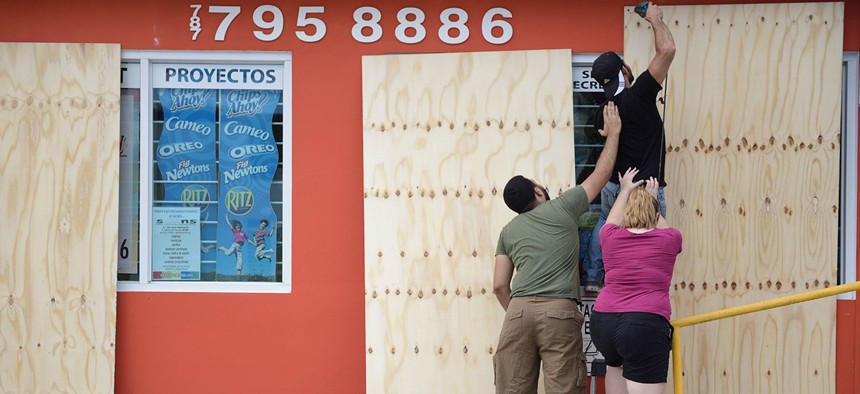Puerto Rico and the Virgin Islands Coordinate with FEMA in Preparation for Irma
A direct hit from one of the strongest storms to ever hit the region will test American disaster response capabilities in the territories.
Hurricane Irma is a monster. After the storm reached Category 5 intensity Tuesday morning, the National Hurricane Center says it became the strongest hurricane ever recorded in the Atlantic outside of the warm waters of the Caribbean or the Gulf of Mexico. And even as the Gulf region of the United States deals with the ongoing devastation of Hurricane Harvey and its week of flooding, coastal areas of the country are again bracing for the worst with Irma.
Much of the national focus has been on Miami, Florida, which sits within Irma’s cone of probability, and is perhaps one of the most susceptible cities in the country to hurricane damage, despite managing to avoid direct hits for decades. But the portents are perhaps even more dire in the U.S. territories in the Caribbean, which along with several island and archipelago nations in that sea will face a direct hit from Irma at its strongest.
As my colleague Marina Koren reports:
Irma is expected to bring “life-threatening wind, storm surge, and rainfall,” to the Leeward Islands, the National Hurricane Center said Tuesday. The hurricane may produce storm surges between seven feet and 11 feet in parts of the British and U.S. Virgin Islands and between two feet and four feet on the northern coast of Puerto Rico.
For comparison, perhaps the most deadly and costly storm in recent history for both Puerto Rico and the Virgin Islands was Hurricane Hugo, a Category 4 storm that hit the region in September 1989 and caused billions of dollars of damage. That storm all but destroyed St. Croix, the largest of the U.S. Virgin Islands, damaging 90 percent of all buildings, making over 20,000 people homeless, and sparking allegations of racism after over 1,000 U.S. troops were sent to restore order in the mostly-black island in the storm’s wake. Hugo was weaker than Irma will be when it’s expected to hit the region: Hugo featured 130 mile-per-hour maximum winds versus Irma’s 180 maximum, and featured a storm surge of 3 feet versus Irma’s expected 7-10 feet.
That 1989 disaster was certainly in mind when I spoke to U.S. Virgin Islands Governor Kenneth Mapp. “Since Hugo we’ve seriously changed our building codes,” Mapp told me. In order to confront the future possibility of hurricanes, the territory has since incorporated uniform building standards and higher wind-ratings for public buildings, created new desalinization plants and reconfigured its water distribution strategy, and rebuilt its power grid so as to be more resilient against major storms.
Despite the strength of Irma, Mapp is “confident that the territory is ready to shelter in this most serious event.” Part of the preparations involve clearing waterways to ensure floodwaters will drain into the ocean, pulling off a coordinated shelter plan—since evacuation isn’t really an option—and coordinating with FEMA partners as residents hunker down for the storm, which is expected to start sending winds and rain to the U.S. Virgin Islands some time between 6 and 7 p.m. ET on Wednesday. Additionally, there are two naval vessels off the coast of Florida ready to coordinate the delivery of aid supplies between a distribution center on Puerto Rico and the Virgin Islands.
Puerto Rico, which like the U.S. Virgin Islands also declared a state of emergency in anticipation of Irma, is also enacting a plan to survive the storm. A press release from Governor Ricardo Rosselló Nevares reports that “FEMA has over 500 officials in Puerto Rico, a medical team, and search and rescue team to collaborate with the Government of Puerto Rico in the event of an emergency.”
The island’s authorities have also moved to limit potential price-gouging by gas stations, opened up hundreds of shelters, are maintaining flood pumps, and are also clearing drainage waterways that lead to the ocean. In a follow-up release in Spanish, Governor Rosselló notes that he met with the mayors of the towns of Rio Grande and Naguabo, and expressed the need to mobilize more physicians and emergency services.
Still, even with the preparations in both territories, and the progress there since the devastation of hurricanes past, Irma presents a grave threat. The biggest structural issue in the islands is not the strength of the buildings or the drainage systems, but extensive poverty, and the ability of government, infrastructure, and health resources to respond in the aftermath.
Nothing highlights the deep structural poverty and inequalities of a place like a disaster, and those fissures are much deeper in Puerto Rico and the U.S. Virgin Islands than most areas in the continental United States. Puerto Rico especially is already in the throes of health and financial issues, and faces deep strain on the infrastructure across the island. And the Virgin Islands, facing the worst of the storm, has its own health-care challenges that might make long-term recovery difficult.
Those issues will make the national relief response critical, even as entities like FEMA have to manage the ongoing Harvey response, and the aftermath of whatever Irma brings to the mainland. According to Mapp, the federal government is listening.
“[White House chief of staff] General John Kelly and I spoke this morning and he had a message from the president,” Mapp told me. “The president wanted me to know and wanted to convey to the people that [the federal government] is paying close attention to the events, that they are fully committed to providing all the resources that the people of the United States Virgin Islands need, and that they will be following up as the event happens.”
“The president wants us to know that we are in his prayers,” continued Mapp. But after a controversial tour through the devastation of Harvey, the Trump administration might have an equally daunting task ahead in the territories.







